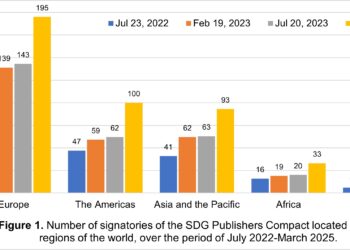
The recent merger news about Macmillan, owners of the Nature Publishing Group (NPG), and Springer, owners of Biomed Central and other properties, hit the market with plenty of force. It’s a major consolidation, and one that ratchets the Macmillan higher education and journals growth strategy up by an order of magnitude. Now, along with Elsevier, Wiley, and Taylor & Francis, we have another multi-billion-dollar publishing behemoth on the market — the combined entity is valued at $5.8 billion.
Measuring by percentage of papers in the market, the new entity takes second place with 13%, just ahead of Wiley (12%), and still far behind Elsevier (23%). By number of journals, the race is nearly neck-and-neck.
In this marriage, Macmillan will end up 53% of the assets, Springer 47%, assuming the merger is approved. Springer, you may recall, has been bouncing around among investors for a while. It is currently owned by BC Partners, a private equity firm. BC Partners has stated that it sees its most likely exit from the business coming via an IPO at some later date, perhaps 2-5 years in the future (sources vary in their estimates).
The merger centers around higher education and science products, and includes Palgrave Macmillan, Scientific American, Macmillan Education Language Learning, Adis Drug Information, Apress, and Springer’s professional publications.
An interesting side note is that the CEO of Macmillan, Annette Thomas, will become the new organization’s Chief Scientific Officer. Derk Haank of Springer will be the new CEO of the combined entity; he is bringing his COO and CFO along, which suggests that the new entity will be focused primarily on financial and operational performance, which makes sense if they are grooming it for an IPO.
There are specific drivers for why these two companies merged, and David Worlock covers it extremely well in a blog post written shortly after the announcement. In addition, as Worlock writes, there is a satisfying nationalistic angle to the deal between Springer and Macmillan’s parent, Holtzbrinck, a German family-owned company:
So both can go happily hand in hand to the German regulator , and get a big tick for accomplishing one of the prized national objectives – keeping Springer, the historical home of German chemistry as it reshaped late nineteenth century science, as a German company.
BC Partners is a German investment company, making this an all-German transaction.
What’s left out of the deal is almost as interesting as what’s included. For instance, Macmillan’s Digital Science is not part of the deal, as a post from Timo Hannay outlined in anodyne terms. This seems like a financial move by Holtzbrinck. Digital Science is in investment mode, meaning that including the property in the current deal would have decreased cash flows and the deal’s inherent value. Also, if the upside of Digital Science proves significant, Holtzbrinck would want to keep it all for itself and not put it into a merger deal in which it might have to share 47% of the revenues. Keeping Digital Science separate also removes risk from a future IPO. In short, there was no upside to including it. It’s unclear if Digital Science will continue to have unfettered access to NPG journals, something that has been key to the deployment of ReadCube and experimentation overall.
The Frontiers OA journals were also not included. It’s unclear why they were not. [Update at 12:36 p.m. ET: Macmillan only has a 30% share in Frontiers, so they were unable to include them based on that minority stake.] They have been kept out of the general rollups going on inside Macmillan in preparation for this merger. The reasoning may be the same as for Digital Science — a group in investment mode, low cash flows, and possible high upside. But taking into account the Springer merger, is there redundancy in the portfolio now that BioMed Central is part of it? Where will that lead? Probably nowhere immediately, if Frontiers isn’t generating much cash, but the neutral position relative to this merger retains options.
Aside from a possible trade-off between Frontiers and BioMed Central, the two organizations will have at least two obviously competitive products in Papers and ReadCube. Papers became part of Springer in 2012, and Holtzbrinck runs Digital Science, which owns ReadCube. Will these two products merge within the portfolio? Or continue to compete?
There is also a tension between the organizations reflected at one point in a leaked email that was circulating last week. While it’s not clear who wrote the email, it came from a Holtzbrinck account, and made an interesting comparison between quality and quantity in the combined portfolio:
. . . we can now proudly say we have a strong position in Open Access service, both in quality (with Nature Communications and Scientific Reports) and quantity (BioMed Central).
The larger theme of the deal is, of course, consolidation around a market that is relatively stable and growing, albeit slowly at a base rate. Consolidation has been occurring overtly and less obviously in the journals and scholarly market for decades, but has accelerated recently in both branded portfolios and mergers and acquisitions. There are some key reasons for this:
- More research outputs. The number of papers continues to increase. This is a major driver for the increasing number and size of journals in the market. Bigger publishers have greater reach, can attract more papers, can sell into more markets, and can launch more journals more easily.
- Relatively flat site license revenues. The market is not natively supporting sufficient price increases. When this happens, other techniques have to be employed to drive revenue growth. The most effective of these it to position yourself to take money from other players in the market by offering more bang for the buck, thereby diverting money from smaller players over into your pockets. The “Big Deal” has been the most obvious technique here, one that has been mimicked by smaller publishers that have expanded their journals portfolios and sold them as packages. Despite being disparaged, the Big Deal still works, and the Small Bundle is also working. All of this places singleton titles at a severe disadvantage, while making contracts with larger publishers more enticing.
- Open access. Commercial open access (OA) publishing has grown significantly over the past 5-7 years. APCs are higher for larger publishers, as RCUK data have repeatedly shown, which makes these publishers eager to solidify their positions. Springer brings BioMed Central to the deal, one of the most successful OA publishers. NPG has been slow to move into the OA realm. As a combined entity, Macmillan-Springer is likely to command higher prices on the market and be in a position to extract further price increases over time.
- Digital workflows and commerce. Digital is not cheaper or simpler than print. The fixed costs of digital publishing are significant, and if not taken to scale, they can overwhelm smaller publishers. Vendors are one way to get some benefits of scale, but vertical integrations inside larger corporations are the most efficient way, as the fixed costs of headcount can be rationalized as well as the technical infrastructure.
- Data publishing. Larger publishers have more data to process, more infrastructure on the technical and sales/marketing fronts, and more reason to leverage all these assets. Prospects for lucrative data publishing are certainly driving consolidation, as more information assets means more data under one roof.
- Globalization. Larger organizations can cover the globe more effectively. Often, regional contacts can generate both business and editorial opportunities — the best papers, better marketing, more sales. Scale is key to addressing the entire globe effectively.
Rick Anderson, who blogs here and is Associate Dean for Scholarly Resources and Collections at the University of Utah, summed it up in a news report from Science:
. . . publishers are fielding more and more submissions and chasing smaller and smaller budgets while also dealing with an increasingly complex scholarly communication environment. It’s a very tough position to be in.
The competition this merger creates at the top of the market — turning a two-billionaire race into a three-billionaire race — is unlikely to trickle down in any helpful way. More Big Deals will leave fewer scraps for others. Some top-end titles may benefit from the increased competition on the acquisitions front, but I don’t think a general bidding war will break out. Society publishing has proven to be a lower-margin business for these companies, and having three vying in the market may make them more conscious of top-end performance, especially if an IPO is in the offing for the new billionaire. The market is too confused by OA, and big players like these are too concerned with maintaining their margins, for them to go fishing far out to sea.
Michael Clarke recently reflected on the challenges in the market for publishers overall, especially in realizing growth. I recently wrote about the costs and complexity of digital publishing. Joe Esposito recently reflected on the inevitability of consolidation in the market. Consolidation helps ameliorate the problems of slow organic growth and increasing fixed costs and greater complexity. In fact, scale solves many problems in a market with more raw materials, increasingly commoditized content, and slow but steady growth. Larger entities can take more of the gains, increasing their rate of growth, while they get more of the raw materials needed for product development and gain efficiencies by spreading their fixed costs across more products.
The lessons from this merger are numerous and important. We are seeing many clues here about what the future holds for our industry. Most important is the continued consolidation on both the seller and buyer sides — larger corporations, larger portfolios on the seller side, matched by institutions, consortia, and OA (which consolidates more purchasing among funders and institutions) on the buyer side. Scale is the new normal, and those without some element of scale to their business may soon find themselves with few options.
Discussion
11 Thoughts on "Macmillan + Springer: Some Lessons to Learn, Some Twists to Watch"
This sounds more like a joint venture than a merger. Both owners still exist, there are majority and minority partners, etc. Not sure the distinction matters, but it might.
I am anxiously awaiting the posts from you, Rick and Joe giving me all the answers to these thought-provoking questions, particularly as they pertain to society publishers. On second thought, maybe just email me instead of posting!
Stock holders and owners demand growth. The time it takes to get a journal or book on the market is numbered in years and signings. It takes too long to grow at the rate demanded and this results in growth by acquisition. In short, it is easier to grow by acquiring companies than internally.
The question now is when will the mid to just large versus mega large be bought up? When will the Walters Kluwer or PLosOne be on the block? How much longer can society publishers last in light of the big deal and costs associated with e production and delivery and the impact on revenue by OA?
Regarding the M&S consolidation. Springer is a large book publisher and figured out that you cannot make much money selling 300 copies of anything. Thus, the have been integrating the book program into the e database.
From their web site:
196,721 Books across all fields of science
eBooks can be used on all reading devices
M&S’s big deal just got bigger
The news of the merger did not come as a surprise. BC Partners bought Springer and soon recognized that they were not large enough or profitable enough for an IPO and at best they might get 1.5 times their investment by selling out to another venture firm. But with a merger of a highly profitable partner could improve their return by 10 times or more. This is a straight forward old fashioned money deal. Those librarians calling this a sign of disruption are simply smoking something. Don’t forget that a small publisher with only 160 journals is worth far more than one publishing 2987. Nature is golden and has been for years. So this is a bet on riches beyond belief with an IPO and everyone makes out like Jack Sparrow. There is gold in them hills!
Great analysis. Buy outs, mergers, IPOs, etc are all about money and have nothing to do with libraries or scholars but a lot to do about ROI.
Imagine if they get a good cascading peer review system in place, and those 10,000 rejected Nature articles trickle down into the Springer journal ecosystem. Mind you, rejected at Nature is not necessarily crap. If the Springer titles improve themselves on the basis of these rejected Nature articles, Elsevier has something to worry about.


